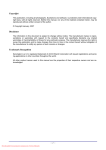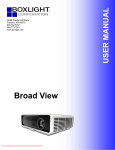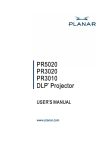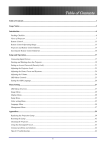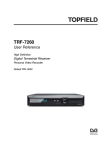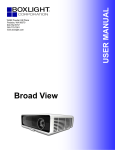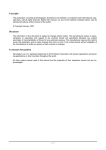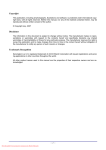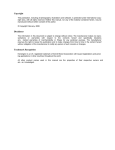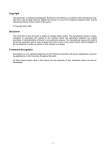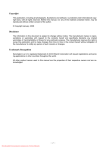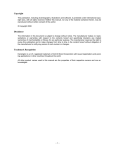Download Vivitek D-220MX User manual
Transcript
Portable DLP projector D-220MX User Manual China Projectors Group Room 207, 2/F., Block B, Seaview Estate, Watson Road, North Point, Hong Kong. Telephone: (852) 28875151 Fax: (852) 25031144 E-mail: [email protected] Website: http://www.chinaprojectors.com Copyright This publication, including all photographs, illustrations and software, is protected under international copyright laws, with all rights reserved. Neither this manual, nor any of the material contained herein, may be reproduced without written consent of the author. © Copyright June, 2006 Disclaimer The information in this document is subject to change without notice. The manufacturer makes no representations or warranties with respect to the contents hereof and specifically disclaims any implied warranties of merchantability or fitness for any particular purpose. The manufacturer reserves the right to revise this publication and to make changes from time to time in the content hereof without obligation of the manufacturer to notify any person of such revision or changes. Trademark Recognition Kensington is a U.S. registered trademark of ACCO Brand Corporation with issued registrations and pending applications in other countries throughout the world. All other product names used in this manual are the properties of their respective owners and are acknowledged. D DLLPP PPrroojjeeccttoorr— —U Usseerr’’ss M Maannuuaall Important Safety Information Congratulations on purchasing the DLP projector! Important: It is strongly recommended that you read this section carefully before using the projector. These safety and usage instructions will ensure that you enjoy many years of safe use of the projector. Keep this manual for future reference. Symbols Used Warning symbols are used on the unit and in this manual to alert you of hazardous situations. The following styles are used in this manual to alert you to important information. Note: Provides additional information on the topic at hand. Important: Provides additional information that should not be overlooked. Caution: Alerts you to situations that may damage the unit. Warning: Alerts you to situations that may damage the unit, create a hazardous environment, or cause personal injury. Throughout this manual, component parts and items in the OSD menus are denoted in bold font as in this example: “Push the Menu button on the remote control to open the Main menu.” Remote Control Some remote controls have a laser for pointing out items on a screen. DANGER: Do not point the laser in the eyes. Doing so can damage the eyes permanently. General Safety Information Do not open the unit case. Aside from the projection lamp, there are no user-serviceable parts in the unit. For servicing, contact qualified service personnel. Follow all warnings and cautions in this manual and on the unit case. The projection lamp is extremely bright by design. To avoid damage to eyes, do not look into the lens when the lamp is on. Do not place the unit on an unstable surface, cart, or stand. Avoid using the system near water, in direct sunlight, or near a heating device. Do not place heavy objects such as books or bags on the unit. — ii — PPrreeffaaccee Power Safety Only use the supplied power cord. Do not place anything on the power cord. Place the power cord where it will not be in the way of foot traffic. Remove the batteries from the remote control when storing or not in use for a prolonged period. Replacing the Lamp Replacing the lamp can be hazardous if done incorrectly. Refer to “Replacing the Projection Lamp” on page 31 for clear and safe instructions for this procedure. Before replacing the lamp: Unplug the power cord. Allow the lamp to cool for about one hour. Spent Lamp Management This product contains a metal halide lamp, which contains mercury. Dispose of it as required by local ordinances and regulations. The USA restricts or prohibits the disposal of some or all mercury containing lamps in the municipal waste stream. Please visit www.lamprecycle.org for more information on specific state disposal requirements and recycling facilities. The following states have laws that deal with information that wholesalers must provide to contractors for lamp disposal. Connecticut Maine Minnesota Rhode Island Cleaning the Projector Unplug the power cord before cleaning. Refer to “Cleaning the Projector” on page 33. Allow the lamp to cool for about one hour. Regulatory Warnings Before installing and using the projector, read the regulatory notices in the “Regulatory Compliance” section on page 44. – iii – D DLLPP PPrroojjeeccttoorr— —U Usseerr’’ss M Maannuuaall Main Features • Lightweight unit, easy to pack away and transport • Compatible with all major video standards including NTSC, PAL, and SECAM • A high brightness rating allows for presentations in daylight or in lit rooms • Supports resolutions up to SXGA at 16.7 million colors to deliver crisp, clear images • Flexible setup allows for front and rear projections • Line-of-vision projections remain square, with advanced keystone correction for angled projections • Input source automatically detected About this manual This manual is intended for end users and describes how to install and operate the DLP projector. Wherever possible, relevant information—such as an illustration and its description—has been kept on one page. This printer-friendly format is both for your convenience and to help save paper, thereby protecting the environment. It is suggested that you only print sections that are relevant to your needs. — iv — PPrreeffaaccee Table of contents GETTING STARTED .......................................................................................................................................................... 1 PACKING CHECKLIST ........................................................................................................................................................... 1 VIEWS OF PROJECTOR PARTS ............................................................................................................................................... 2 Front-right View ............................................................................................................................................................. 2 Top view—On-screen Display (OSD) buttons and LEDs ............................................................................................... 3 Rear view ........................................................................................................................................................................ 4 Bottom view..................................................................................................................................................................... 5 REMOTE CONTROL PARTS (26-BUTTON MODEL)................................................................................................................. 6 REMOTE CONTROL OPERATING RANGE ............................................................................................................................... 8 PROJECTOR AND REMOTE CONTROL BUTTONS .................................................................................................................... 8 SETUP AND OPERATION............................................................................................................................................... 10 INSERTING THE REMOTE CONTROL BATTERIES ................................................................................................................ 10 CONNECTING INPUT DEVICES ............................................................................................................................................ 11 STARTING AND SHUTTING DOWN THE PROJECTOR ............................................................................................................. 12 SETTING AN ACCESS PASSWORD (SECURITY LOCK) .......................................................................................................... 13 ADJUSTING THE PROJECTOR LEVEL ................................................................................................................................... 14 ADJUSTING THE ZOOM, FOCUS AND KEYSTONE ................................................................................................................ 15 ADJUSTING THE VOLUME .................................................................................................................................................. 16 ADJUSTING WITH THE PROJECTOR QUICK MENU BUTTON ................................................................................................. 17 ON-SCREEN DISPLAY (OSD) MENU SETTINGS....................................................................................................... 18 OSD MENU CONTROLS ..................................................................................................................................................... 18 Navigating the OSD ...................................................................................................................................................... 18 SETTING THE OSD LANGUAGE .......................................................................................................................................... 19 MAIN MENU ...................................................................................................................................................................... 20 Main Menu Functions Available for Connected Source ............................................................................................... 21 SETUP MENU ..................................................................................................................................................................... 22 Setup Menu Functions Available for Connected Source............................................................................................... 22 Advance Feature ........................................................................................................................................................... 23 User Color .................................................................................................................................................................... 25 CONFIG MENU ................................................................................................................................................................... 26 UTILITY MENU .................................................................................................................................................................. 27 Utility Menu Functions Available for Connected Source ............................................................................................. 28 LANGUAGE MENU ............................................................................................................................................................. 29 STATUS MENU ................................................................................................................................................................... 30 MAINTENANCE AND SECURITY................................................................................................................................. 31 REPLACING THE PROJECTION LAMP................................................................................................................................... 31 Resetting the Lamp........................................................................................................................................................ 33 CLEANING THE PROJECTOR................................................................................................................................................ 33 Cleaning the Lens ......................................................................................................................................................... 34 Cleaning the Case ......................................................................................................................................................... 34 USING THE KENSINGTON® LOCK ...................................................................................................................................... 34 TROUBLESHOOTING ..................................................................................................................................................... 35 COMMON PROBLEMS AND SOLUTIONS ............................................................................................................................... 35 TIPS FOR TROUBLESHOOTING ............................................................................................................................................ 35 LED ERROR MESSAGES .................................................................................................................................................... 36 IMAGE PROBLEMS .............................................................................................................................................................. 36 LAMP PROBLEMS ............................................................................................................................................................... 37 REMOTE CONTROL PROBLEMS .......................................................................................................................................... 37 AUDIO PROBLEMS ............................................................................................................................................................. 37 HAVING THE PROJECTOR SERVICED .................................................................................................................................. 38 SPECIFICATIONS............................................................................................................................................................. 39 SPECIFICATIONS................................................................................................................................................................. 39 Input/output connectors ................................................................................................................................................ 40 –v– D DLLPP PPrroojjeeccttoorr— —U Usseerr’’ss M Maannuuaall PROJECTION DISTANCE V.S. PROJECTION SIZE ................................................................................................................. 41 TIMING MODE TABLE ........................................................................................................................................................ 42 PROJECTOR DIMENSIONS ................................................................................................................................................... 43 REGULATORY COMPLIANCE ..................................................................................................................................... 44 FCC WARNING .................................................................................................................................................................. 44 CANADA ............................................................................................................................................................................ 44 SAFETY CERTIFICATIONS ................................................................................................................................................... 44 EN 55022 WARNING ......................................................................................................................................................... 44 — vi — GETTING STARTED Packing Checklist The remote control that ships with the projector depends on the model you purchased. Carefully unpack the projector and check that the following items are included: DLP PROJECTOR WITH POWER CORD USB CABLE (USB TYPE A-TO-MINI USB) COMPOSITE VIDEO CABLE (MINI JACK-TO-RCA) REMOTE CONTROL (WITH TWO AAA BATTERIES) LENS CAP S-VIDEO CABLE (MINI JACK-TO-S-VIDEO) CD-ROM (THIS USER’S MANUAL) AUDIO CABLE (MINI JACK-TO-RCA X 2) QUICK START GUIDE COMPUTER CABLE (DVI-DB15) CARRYING CASE Contact your dealer immediately if any items are missing, appear damaged, or if the unit does not work. Caution: Avoid using the projector in dusty environments. D DLLPP PPrroojjeeccttoorr— —U Usseerr’’ss M Maannuuaall Views of Projector Parts Front-right View 1 2 6 ITEM LABEL 5 4 3 DESCRIPTION SEE PAGE: 1. See “Top view—OSD buttons and LEDs” on next page 2. Rear IR receiver Receiver for IR signal from remote control 3. Lens zoom Enlarges the projected image 4. Focus Focuses the projected image 5. Height-adjuster button Push to release height adjuster 14 6. Front IR receiver Receiver for IR signal from remote control 8 8 15 Important: Ventilation openings on the projector allow for good air circulation, which keeps the projector lamp cool. Do not obstruct any of the ventilation openings. –2– D DLLPP PPrroojjeeccttoorr –– U Usseerr’’ss M Maannuuaall Top view—On-screen Display (OSD) buttons and LEDs 1 ITEM 1. 2. 2 LABEL Ready LED Power LED 34 5 6 7 DESCRIPTION SEE PAGE: Orange Lamp ready—you can safely turn on or off the projector Flashing Lamp not ready—do not press the power button Green Unit is powered on and working correctly Off Unit is powered off Flashing Operational error code (refer to “LED Error Messages” on page 36) 3. Power button Turns the projector on or off 12 4. Menu Opens and exits the OSD 18 5. Source/ Left cursor Detects the input device Navigates and changes settings in the OSD 12 18 6. Quick Menu/ 17 Down cursor Opens a Quick Menu for brightness, contrast, volume, and keystone adjustment Navigates and changes settings in the OSD Auto/ Right cursor Optimizes image size, position, and resolution Navigates and changes settings in the OSD 18 7. –3– 18 D DLLPP PPrroojjeeccttoorr— —U Usseerr’’ss M Maannuuaall Rear view 1 ITEM 2 LABEL 3 4 5 6 7 DESCRIPTION SEE PAGE: 1. Power Connect the supplied power cord 12 2. Rear IR receiver Receiver for IR signal from remote control 8 3. USB Connect the USB cable from a computer 4. Audio-in Connect the audio cable from the input device 5. Video/S-video Connect the composite or S-video cable from a video device 6. DVI-I Connect the computer cable from a computer 7. Security Lock Secure to permanent object with a Kensington® Lock system 11 34 Note: If your video equipment has both S-video and RCA jacks (composite video) connect to the S-video connector. S-video provides a better quality signal. –4– D DLLPP PPrroojjeeccttoorr –– U Usseerr’’ss M Maannuuaall Bottom view 1 ITEM 2 LABEL 3 DESCRIPTION 1. Height-adjuster button Push to release height adjuster 2. Height adjuster Adjusts level of projector 3. Projection lamp cover Remove when changing lamp SEE PAGE: 14 –5– 31 D DLLPP PPrroojjeeccttoorr— —U Usseerr’’ss M Maannuuaall Remote Control Parts 28 1 2 27 3 4 26 25 5 6 7 8 24 23 22 9 10 21 20 19 11 12 18 13 17 14 16 15 Important: 1. Avoid using the projector with bright fluorescent lighting turned on. Certain high-frequency fluorescent lights can disrupt remote control operation. 2. Be sure nothing obstructs the path between the remote control and the projector. If the path between the remote control and the projector is obstructed, you can bounce the signal off certain reflective surfaces such as projector screens. 3. The buttons and keys on the projector have the same functions as the corresponding buttons on the remote control. This user’s manual describes the functions based on the remote control. ITEM LABEL DESCRIPTION 1. IR transmitter Transmits signals to projector 2. Status LED Lights when the remote control is used –6– SEE PAGE: D DLLPP PPrroojjeeccttoorr –– U Usseerr’’ss M Maannuuaall ITEM LABEL DESCRIPTION 3. Laser Press to operate the on-screen pointer 4. Up Up arrow when connected through USB to a PC 5. Right Right arrow when connected through USB to a PC 6. Down Down arrow when connected through USB to a PC 7. Page Down Page down when connected through USB to a PC 8. Up cursor 9. Right cursor 10. Down cursor 11. SEE PAGE: Navigates and changes settings in the OSD 18 Volume +/- Adjusts volume 16 12. Mute Mutes the built-in speaker 13. Zoom+ Zoom in 14. Zoom- Zoom out 15. Freeze Freeze/unfreezes the on-screen picture 16. Blank Makes the screen blank 17. Source Detects the input device 18. Auto Auto adjustment for phase, tracking, size, position 19. Menu Opens the OSD 18 20. Status Opens the OSD Status menu (the menu only opens when an input device is detected) 30 21. Keystone top/bottom Corrects image-trapezoid (wider top/bottom) effect 22. Left cursor Navigates and changes settings in the OSD 23. Enter Changes settings in the OSD 24. Page Up Page up when connected through USB to a PC 25. Left Left arrow when connected through USB to a PC 26. Enter Enter key when connected through USB to a PC 27. Power Turns the projector on or off 15 18 –7– 12 D DLLPP PPrroojjeeccttoorr— —U Usseerr’’ss M Maannuuaall ITEM 28. LABEL Laser DESCRIPTION SEE PAGE: Use as on-screen pointer. DO NOT POINT IN EYES. Note: The remote control can only interface with a computer when connected to the computer through a USB cable connection. The computer cable connects a computer to the projector for display purposes only. Remote Control Operating Range The remote control uses infrared transmission to control the projector. It is not necessary to point the remote directly at the projector. Provided you are not holding the remote perpendicular to the sides or the rear of the projector, the remote will function well within a radius of about 10 meters (33 feet) and 30 degrees above or below the projector level. If the projector does not respond to the remote control, move a little closer. Projector and Remote Control Buttons The projector can be operated using the remote control or the buttons on the top of the projector. All operations can be carried out with the remote control; however the buttons on the projector are limited in use. The following illustrations show the corresponding buttons on the remote control and on the projector. Some buttons on the projector have two functions. For example, item 3/6 on the projector functions both as the source button and as the left cursor key in OSD menus. 1 7 2 3 6 1 5 6 4/7 3 5/2 4 Some buttons on the projector have two functions. For example, item 4/7 on the projector functions both as the source button and as the left cursor key in OSD menus. –8– D DLLPP PPrroojjeeccttoorr –– U Usseerr’’ss M Maannuuaall –9– SETUP AND OPERATION Inserting the Remote Control Batteries (26-button Model) 1. 2. 3. Remove the battery compartment cover by sliding the cover in the direction of the arrow. Insert the supplied batteries taking note of the polarity (+/-) as shown here. Replace the cover. Caution: 1. Only use AAA alkaline batteries. 2. Dispose of used batteries according to local ordinance regulations. 3. Remove the batteries when not using the projector for prolonged periods. D DLLPP PPrroojjeeccttoorr –– U Usseerr’’ss M Maannuuaall Connecting Input Devices A PC or notebook computer as well as video devices can be connected to the projector at the same time. Video devices include DVD, VCD, and VHS players, as well as movie camcorders and digital still cameras. Check the user manual of the connecting device to confirm it has the appropriate output connector. A ITEM B C LABEL D DESCRIPTION A USB Connect the supplied USB cable from a computer. B Audio-in Connect an audio cable (not supplied) from the computer’s audio-out connector. C Video/ S-video Connect the supplied composite video cable from a video device. Connect the supplied S-video cable from a video device. D DVI-I Connect the supplied computer cable from a computer. Connect the supplied audio cable (mini jack-to-RCA x 2) from a video device. Warning: As a safety precaution, disconnect all power to the projector and connecting devices before making connections. – 11 – D DLLPP PPrroojjeeccttoorr— —U Usseerr’’ss M Maannuuaall Starting and Shutting down the Projector 1. 2. 3. 4. Remove the lens cover. Connect the power cord to the projector. Connect the other end to a wall outlet. The POWER and READY LEDs on the projector turn on. Turn on the connected devices. Ensure the Ready LED is on a steady (not flashing) orange and then press the Power button to turn on the projector. The projector splash screen displays and connected devices are detected. If the connected device is a PC, press the appropriate keys on the computer keyboard to switch the display output to the projector. (Check the user manual of the PC to determine the appropriate Fn key combination to change display output.) See “Setting an Access Password (Security Lock)” on page 13 if Security Lock is enabled. 5. 6. 7. If more than one input device is connected, press the Source button repeatedly to switch among devices. (DVD and HDTV are supported through the DVI-I connector.) To turn off the projector, press the Power button. The projector prepares for shutdown and a “Wait a moment please…” message appears. When the “Power Off?/Press Power again” message appears, press the Power button. The projector turns off. Caution: Do not unplug the power cord until the Ready LED stops flashing, indicating the projector has cooled down. – 12 – D DLLPP PPrroojjeeccttoorr –– U Usseerr’’ss M Maannuuaall Setting an Access Password (Security Lock) You can use the cursor (arrow) buttons to set a password and prevent unauthorized use of the projector. When enabled, the password must be entered after you power on the projector. (See “Navigating the OSD” on page 18 and “Setting the OSD Language” on page 19 for help on using OSD menus.) Important: Keep the password in a safe place. Without the password, you will not be able to use the projector. If you lose the password, contact your reseller for information on clearing the password. 1. 2. 3. 4. 5. 6. Press the Menu button to open the OSD menu. Press the cursor Setup menu. button to move to the Press the cursor button to select Advance Feature and press Enter or . Press the cursor rity Lock. button to select Secu- Press the cursor button to select Enable. (White text is selected.) A password dialog box automatically appears. You can only use the following three cursor buttons: in the password fields. You can use any combination including the same arrow four times, but not less than four. Press the cursor buttons in any order to set the password. When you confirm the password, OK appears. Every time you start the projector, a password dialog box appears. Enter the password in the order you set it at step 6. (Press the Menu button to cancel if you enter the wrong password.) – 13 – D DLLPP PPrroojjeeccttoorr— —U Usseerr’’ss M Maannuuaall Adjusting the Projector Level Take note of the following when setting up the projector: • The projector table or stand should be level and sturdy. • Position the projector so that it is perpendicular to the screen. • Be sure cables are not in the way or can cause the projector to be knocked over. A B C 1. To raise the level of the projector, lift the projector [A] and press the height-adjuster button [B]. The height adjuster drops down [C]. 2. To lower the level of the projector, press the height-adjuster button and push down on the top of the projector. – 14 – D DLLPP PPrroojjeeccttoorr –– U Usseerr’’ss M Maannuuaall Adjusting the Zoom, Focus and Keystone 1. 2. 3. Use the Image-zoom control (on the projector only) to resize the projected image and screen size A . A Use the Image-focus control (on the projector only) to sharpen the projected image B . B Press the Keystone button on the remote control. The keystone control appears on the display. (See page 17 to adjust keystone with the Quick Menu button on the projector.) (15-button Model) (26-button Model) 4. Use the Keystone button to correct image distortion. – 15 – D DLLPP PPrroojjeeccttoorr— —U Usseerr’’ss M Maannuuaall Adjusting the Volume 1. Press the Volume +/- button on the remote control. The volume control appears on the display. (See page 17 to adjust volume with the Quick Menu button on the projector.) (15-button Model) (26-button Model) 2. 3. Use the Volume +/- button to adjust the level. Press the Mute button to turn off the volume. – 16 – D DLLPP PPrroojjeeccttoorr –– U Usseerr’’ss M Maannuuaall Adjusting with the Projector Quick Menu Button Use the Quick Menu button on the projector to adjust brightness, contrast, volume, and keystone. 1. 2. 3. Press the Quick Menu button. The brightness control appears on the display. Press the Quick Menu button repeatedly to scroll through the options contrast, volume, and keystone. Use the /Source and Auto/ buttons to adjust the value. The slider menu closes automatically. – 17 – ON-SCREEN DISPLAY (OSD) MENU SETTINGS OSD Menu Controls The projector has an OSD that lets you make image adjustments and change various settings. Navigating the OSD You can use the remote control cursor buttons or the buttons on the top of the projector to navigate and make changes to the OSD. The following illustration shows the corresponding buttons on the remote control and on the projector. 1 4 2 3 3 4 2 1 1. To open the OSD, press the Menu button. 2. There are six menus. Press the cursor ton to move through the menus. 3. Press the cursor down in a menu. but- button to move up and to change values for settings, and 4. Press then press Enter or to confirm the new setting. 5. Press Menu to close the OSD or leave a submenu. Note: Depending on the video source not all items in the OSD are available. For example, the Horizontal/Vertical Position items in the Setup menu can only be modified when connected to a PC. Items that are not available cannot be accessed and are grayed out. D DLLPP PPrroojjeeccttoorr –– U Usseerr’’ss M Maannuuaall Setting the OSD Language You may want to reference the OSD on your projector while reading this section. Set the OSD language to your preference before continuing. (The default language is English.) 1. Press the Menu button. The Main menu appears. 2. Press the cursor 3. Press the cursor 4. Press the cursor button until Language is highlighted. button until the language you want is highlighted. or Enter button to confirm the language. 5. Press the Menu button twice to close the OSD. – 19 – D DLLPP PPrroojjeeccttoorr— —U Usseerr’’ss M Maannuuaall Main Menu Press the Menu button to open the OSD menu. Press the cursor button to move to the Main button to move up and down in the Main menu. Press to change menu. Press the cursor values for settings, and then press Enter or to confirm the new setting. ITEM DESCRIPTION DEFAULT Brightness Press the cursor button to adjust the brightness. (Range: 0 – 100) 50 Contrast Press the cursor button to adjust the contrast. (Range: 0 – 100) 50 Sharpness Press the cursor button to adjust the display sharpness (Range: 1-5) 3 Color Temperature Press the cursor button to adjust the video tint/hue. (Range: Cool/Normal/Warm) Color Saturation Press the cursor button to adjust the video saturation. (Range: 0 – 100) 50 Color Tint Press the cursor button to adjust the video tint/hue. (Range: 0 – 100) 50 Gamma Press the cursor button to adjust the gamma correction of the display. PC Color Space Input Gamma Brightness PC MAC Video Chart B&W 2.2 1.8 2.4 2.2 2.4 High High Low Low High Press the cursor button to adjust the color space. (Range: Auto – RGB – YPbPr- YCbCr ) – 20 – Normal Auto D DLLPP PPrroojjeeccttoorr –– U Usseerr’’ss M Maannuuaall ITEM Reset DESCRIPTION DEFAULT Resets all Main settings to default values — Main Menu Functions Available for Connected Source Function RGB DVI Component Video Composite Video S-video Brightness x x x x x Contrast x x x x x Sharpness x x x x x Color Temp x x x x x Color Saturation x x x Color Tint x x x Gamma x x x x x Color Space x x x x x Reset x x x x x x = available to video source – 21 – D DLLPP PPrroojjeeccttoorr— —U Usseerr’’ss M Maannuuaall Setup Menu Press the Menu button to open the OSD menu. Press the cursor button to move to the Setup button to move up and down in the Setup menu. Press to change menu. Press the cursor values for settings, and then press Enter or to confirm the new setting. ITEM DESCRIPTION DEFAULT Horizontal Position Press the cursor button to move the image left or right. (Range: 0 – 100) 50 Vertical Position Press the cursor button to move the image up or down. (Range: 0 – 100) 50 Keystone Press the cursor button to correct distortion of the projected image. (Range: -50 – +50) Aspect Ratio Press the cursor button to toggle between the 4:3 standard format and the 16:9 High Definition TV (HDTV) format. 4:3 Advance Feature See “Advance Feature” on page 23. — Reset Resets Keystone and Aspect Ratio to default values — 0 Setup Menu Functions Available for Connected Source Function RGB H Position x V Position x DVI Component Video – 22 – Composite Video S-video D DLLPP PPrroojjeeccttoorr –– U Usseerr’’ss M Maannuuaall Function RGB DVI Component Video Composite Video S-video Keystone correction x x x x x Aspect Ratio x x x x x Advance Feature x x x x x Reset x x x x x x = available to video source Advance Feature to move to the Setup menu. Press to Press the Menu button to open the OSD menu. Press to move up and down in move to the Advance Feature menu and then press Enter or . Press the Advance Feature menu. Press to change values for settings, and then press Enter or to confirm the new setting. ITEM User Color DESCRIPTION DEFAULT This feature adjusts the color balance in each color of RGB (red, green, blue), and their neutral colors (cyan, magenta, yellow, white) by using color correction adjustment. Increasing a color’s setting heightens the intensity of that color on the screen, while a lower setting makes the color less intense. 80 Press Press White Peaking to adjust the selected color. (Range: 0 – 100) White Peaking increases the output in the brightest whites without changing the blacks and dark grays. It crushes the whites slightly, but it does not appear to clip them or seriously obscure white detail. If you prefer a stronger image, adjust toward the maximum setting. For a smoother, more natural image, adjust toward the minimum setting. Press Logo Display to select a color. Data source: 10 Video source: 2 to adjust the value of white peaking. (Range: 0 – 10) Press to enable or disable if the logo displays when the projector starts, and when no source is detected. (Range: On – Off) – 23 – On D DLLPP PPrroojjeeccttoorr— —U Usseerr’’ss M Maannuuaall ITEM Auto Keystone DESCRIPTION When enabled, keystone correction is automatically calibrated when you press the Auto button on the remote control or the keypad. Press DEFAULT Off to enable or disable Auto Keystone. AutoKeystone Calibrate Press Enter or Fan Speed Press the cursor to automatically calibrate keystone correction. button to toggle between Normal and High fan speeds. — Normal Set Fan Speed to High in altitudes over 3,000 meters (10,000 feet). Security Lock Press the cursor button to enable or disable Security Lock. When you enable Security Lock a Register Password dialog box appears: No password You can only use the following three cursor buttons, in the password fields. Press the cursor buttons four times in any order and confirm to set the password. When the password is enabled, it must be entered every time after you power on the projector. See “Setting an Access Password (Security Lock)” on page 13 for steps on setting the password. Reset Resets White Peaking, Logo Display, Fan Speed, and Auto Keystone settings to default values — Note: If Security Lock is enabled, you must enter the password every time the projector is turned on. However, if the projector is already turned on, Security Lock can be disabled without knowing the current password. – 24 – D DLLPP PPrroojjeeccttoorr –– U Usseerr’’ss M Maannuuaall User Color to Press the Menu button to open the OSD menu. Press to move to the Setup menu. Press to move to the User move to the Advance Feature menu and then press Enter or . Press to move up and down to select a color. Press Color menu and then press Enter or . Press to change values for settings, and then press Enter or to confirm the new setting. ITEM DESCRIPTION DEFAULT Red Green Press the cursor button to adjust the red color level. (Range: 0 - 100) Press the cursor button to adjust the green color level. (Range: 0 - 100) 80 80 Blue Press the cursor button to adjust the blue color level. (Range: 0 - 100) 80 Cyan Press the cursor button to adjust the cyan color level. (Range: 0 - 100) 80 Magenta Press the cursor button to adjust the magenta color level. (Range: 0 - 100) 80 Yellow Press the cursor button to adjust the yellow color level. (Range: 0 - 100) 80 White Press the cursor button to adjust the white color level. (Range: 0 - 100) Resets all User Color settings to default values Reset – 25 – 80 — D DLLPP PPrroojjeeccttoorr— —U Usseerr’’ss M Maannuuaall Config Menu Press the Menu button to open the Main menu. Press the cursor button to move to the Config button to move up and down in the Config menu. Press to change menu. Press the cursor values for settings, and then press Enter or to confirm the new setting. ITEM DESCRIPTION DEFAULT Blank Screen Press the cursor button to select a background color for the blank screen. (Range: Black – Red – Green – Blue – White) Auto Source button to enable or disable automatic source detecPress the cursor tion. (Range: On – Off) On Auto Power Off Press the cursor button to enable or disable automatic shut-down of lamp after 10 minutes of inactivity. (Range: On – Off) Off Volume Menu Position Press the cursor Menu Display button to determine the timeout delay of the OSD. Press the cursor (Range: 10 – 20 sec.) Press the cursor button to set menu screen translucency. (Range: 0% – 100%) Resets all Config items to default values Translucent Menu Reset button to adjust the audio volume level. (Range: 0 - 8) Press the cursor button to position the OSD on screen. (Range: Left – Right – Center – Down – Up) Note: The Config menu functions are available to all video sources. – 26 – Blue 4 Center 15 0% D DLLPP PPrroojjeeccttoorr –– U Usseerr’’ss M Maannuuaall Utility Menu Press the Menu button to open the Main menu. Press the cursor button to move to the Utility button to move up and down in the Utility menu. Press to change menu. Press the cursor values for settings, and then press Enter or to confirm the new setting. ITEM DESCRIPTION Video Type Press the cursor button to select the video standard (Range: Auto – NTSC – PAL – SECAM) Video AGC Press the cursor button to enable or disable automatic gain control for the video source. (Range: On – Off) Projection Press the cursor methods: button to choose from two projection DEFAULT Auto On Desktop front Desktop mount, front of screen Desktop mount, rear of screen Frequency Press the cursor button to adjust the A/D sampling clock. (Range: 0° - 180°) Auto detected Tracking Press the cursor button to adjust the A/D sampling number. (Range: 0 - 100) Auto detected – 27 – D DLLPP PPrroojjeeccttoorr— —U Usseerr’’ss M Maannuuaall ITEM Digital Zoom DESCRIPTION DEFAULT Digital operation for zoom and pan adjustment. Press Enter or . The Zoom menu appears. — Press to zoom in; press to zoom out. Press Enter or to open the Pan menu. (You must zoom in before you can open the Pan menu.) Use the cursor buttons to pan the zoomed image. Press the Menu button to exit. Reset Resets Video Type, Video AGC, Projection, and Digital Zoom to default values — Utility Menu Functions Available for Connected Source Function RGB Composite Video S-video Video Type x x Video AGC x x x x x x x x x x Projection X Frequency x Tracking x Digital Zoom x Reset x DVI x Component Video x x x x = available to video source – 28 – D DLLPP PPrroojjeeccttoorr –– U Usseerr’’ss M Maannuuaall Language Menu Press the Menu button to open the Main menu. Press the cursor button to move to the Lanbutton to move up and down in the Language menu. Press Enter guage menu. Press the cursor or to confirm the new setting. ITEM DESCRIPTION DEFAULT English French German Italian Spanish Swedish Press the cursor menu. button to move up and down in the English Chinese Simplified Chinese Traditional Press the Enter or to confirm the language. Japanese Korean Portuguese Russian – 29 – D DLLPP PPrroojjeeccttoorr— —U Usseerr’’ss M Maannuuaall Status Menu Press the Menu button to open the Main menu. Press the cursor button to move to the Status button to move up and down in the Status menu. menu. Press the cursor ITEM DESCRIPTION Video Information Displays the resolution and refresh rate for RGB/DVI mode. Displays the color standard for video mode. Active Source Displays the active source. Software Version Displays information about the software version. Lamp Hours Shows the number of hours lamp has been in use for Eco and Normal modes. Lamp Mode Press the cursor button to choose the lamp mode. Range: Eco; Normal. DEFAULT These items are display only. Normal Eco mode uses less power and extends lamp life, but decreases lamp brightness. Lamp Hour Reset After replacing the lamp, this item should be reset. Refer to “Replacing the Projection Lamp” on page 31. – 30 – — MAINTENANCE AND SECURITY Replacing the Projection Lamp The projection lamp should be replaced when it burns out. It should only be replaced with a certified replacement part, which you can order from your local dealer. Important: 1. The lamp contains a certain amount of mercury and should be disposed of according to local ordinance regulations. 2. Avoid touching the glass surface of the new lamp: Doing so may shorten its operation life. Warning: Be sure to turn off and unplug the projector at least an hour before replacing the lamp. Failure to do so could result in a severe burn. 1. 2. Loosen the two captive screws on the lamp compartment cover (A). Remove the lamp compartment cover (B). A B A D DLLPP PPrroojjeeccttoorr— —U Usseerr’’ss M Maannuuaall 3. 4. A Remove the two screws from the lamp module (A). Lift the module handle up (B). B 5. Pull firmly on the module handle to remove the lamp module. 6. Reverse steps 1 to 5 to install the new lamp module. – 32 – D DLLPP PPrroojjeeccttoorr –– U Usseerr’’ss M Maannuuaall Resetting the Lamp After replacing the lamp, you should reset the lamp hour counter to zero. Refer to the following: 1. 2. 3. 4. Press the Menu button to open the Main menu. Press the cursor button to move to the Status menu. Press the cursor button to move down to Lamp Hour Reset. Press the cursor or Enter button. A message screen appears. 5. Press the cursor buttons in this order: ; ; ; . The Status menu appears again showing the Lamp Hours reset to zero. Cleaning the Projector Cleaning the projector to remove dust and grime will help ensure trouble-free operation. Warning: 1. Be sure to turn off and unplug the projector at least an hour before cleaning. Failure to do so could result in a severe burn. 2. Use only a dampened cloth when cleaning. Do not allow water to enter the ventilation openings on the projector. 3. If a little water gets into the projector interior while cleaning, leave unplugged in a well-ventilated room for several hours before using. 4. If a lot of water gets into the projector interior when cleaning, have the projector serviced. – 33 – D DLLPP PPrroojjeeccttoorr— —U Usseerr’’ss M Maannuuaall Cleaning the Lens You can purchase optic lens cleaner from most camera stores. Refer to the following to clean the projector lens. 1. Apply a little optic lens cleaner to a clean soft cloth. (Do not apply the cleaner directly to the lens.) 2. Lightly wipe the lens in a circular motion. Caution: 1. Do not use abrasive cleaners or solvents. 2. To prevent discoloration or fading, avoid getting cleaner on the projector case. Cleaning the Case Refer to the following to clean the projector case. 1. Wipe off dust with a clean dampened cloth. 2. Moisten the cloth with warm water and mild detergent (such as used to wash dishes), and then wipe the case. 3. Rinse all detergent from the cloth and wipe the projector again. Caution: To prevent discoloration or fading of the case, do not use abrasive alcohol-based cleaners. Using the Kensington® Lock If you are concerned about security, attach the projector to a permanent object with the Kensington slot and a security cable. Note: Contact your vendor for details on purchasing a suitable Kensington security cable. The security lock corresponds to Kensington’s MicroSaver Security System. If you have any comment, contact: Kensington, 2853 Campus Drive, San Mateo, CA94403, U.S.A. Tel: 800-535-4242, http://www.Kensington.com. – 34 – TROUBLESHOOTING Common problems and solutions These guidelines provide tips to deal with problems you may encounter while using the projector. If the problem remains unsolved, contact your dealer for assistance. Often after time spent troubleshooting, the problem is traced to something as simple as a loose connection. Check the following before proceeding to the problem-specific solutions. • Use some other electrical device to confirm that the electrical outlet is working. • Ensure the projector is turned on. • Ensure all connections are securely attached. • Ensure the attached device is turned on. • Ensure a connected PC is not in suspend mode. • Ensure a connected notebook computer is configured for an external display. (This is usually done by pressing an Fn-key combination on the notebook.) Tips for Troubleshooting In each problem-specific section, try the steps in the order suggested. This may help you to solve the problem more quickly. Try to pin point the problem and thus avoid replacing non-defective parts. For example, if you replace batteries and the problem remains, put the original batteries back and go to the next step. Keep a record of the steps you take when troubleshooting: The information may be useful when calling for technical support or for passing on to service personnel. D DLLPP PPrroojjeeccttoorr— —U Usseerr’’ss M Maannuuaall LED Error Messages LED STATUS/ NUMBER OF FLASHES Ready Flashing Power DESCRIPTION Lamp not ready—do not press the power button 1 Fan1 error 2 Fan2 error 2 System task created error 3 System overheating 4 System interface error 5 Lamp error 6 Fan error (refer to Ready LED status to determine which fan) 7 Lamp cover open 8 DLP driver error 9 Color wheel error Image Problems Problem: No image appears on the screen 1. Verify the settings on your notebook or desktop PC. 2. Turn off all equipment and power up again in the correct order. Problem: The image is blurred 1. Adjust the Focus on the projector. 2. Press the Auto button on the remote control or projector. 3. Ensure the projector-to-screen distance is within the 10-meter (33-feet) specified range. 4. Check that the projector lens is clean. Problem: The image is wider at the top or bottom (trapezoid effect) 1. Position the projector so it is as perpendicular to the screen as possible. 2. Use the Keystone button on the remote control or projector to correct the problem. Problem: The image is reversed or upside down Check the Projection setting on the Utility menu of the OSD. Problem: The image is streaked 1. Set the Frequency and Tracking settings on the Utility menu of the OSD to the default settings. 2. To ensure the problem is not caused by a connected PC’s video card, connect to another computer. – 36 – D DLLPP PPrroojjeeccttoorr –– U Usseerr’’ss M Maannuuaall Problem: The image is flat with no contrast Adjust the Contrast setting on the Main menu of the OSD. Problem: The color of the projected image does not match the source image. Adjust the Color Temperature and Gamma settings on the Main menu of the OSD. Lamp Problems Problem: There is no light from the projector 1. Check that the power cable is securely connected. 2. Ensure the power source is good by testing with another electrical device. 3. Restart the projector in the correct order and check that the Power LED is green. 4. If you have replaced the lamp recently, try resetting the lamp connections. 5. Replace the lamp module. 6. Put the old lamp back in the projector and have the projector serviced. Problem: The lamp goes off 1. Power surges can cause the lamp to turn off. Press the power button twice to turn off the projector. When the Ready LED is on, press the power button. 2. Replace the lamp module. 3. Put the old lamp back in the projector and have the projector serviced. Remote Control Problems Problem: The projector does not respond to the remote control 1. Direct the remote control towards remote sensor on the projector. 2. Ensure the path between remote and sensor is not obstructed. 3. Turn off any fluorescent lights in the room. 4. Check the battery polarity. 5. Replace the batteries. 6. Turn off other Infrared-enabled devices in the vicinity. 7. Have the remote control serviced. Audio Problems Problem: There is no sound 1. Adjust the volume on the remote control. 2. Adjust the volume of the audio source. 3. Check the audio cable connection. 4. Test the source audio output with other speakers. 5. Have the projector serviced. Problem: The sound is distorted 1. Check the audio cable connection. 2. Test the source audio output with other speakers. 3. Have the projector serviced. – 37 – D DLLPP PPrroojjeeccttoorr— —U Usseerr’’ss M Maannuuaall Having the Projector Serviced If you are unable to solve the problem, you should have the projector serviced. Pack the projector in the original carton. Include a description of the problem and a checklist of the steps you took when trying to fix the problem: The information may be useful to service personnel. For servicing, return the projector to the place you purchased it. – 38 – SPECIFICATIONS Specifications Display type TI DMD 0.7-inch x 1, 12 degrees, DDR DLP with DDP 2000 ASIC controller Resolution XGA 1024 x 768 native Color 16.7 Million (24-bits/pixel) Bandwidth Up to 140 MHz Weight <1.13 kg (<2.5 lbs.) Projection distance 1.5 to 7 meters (59 to 276 inches) Projection screen size 0.89 to 4.86 meters (35.15 to 191.38 inches) Brightness uniformity Typical 80%; 70% Projection lens Manual and digital zoom; manual focus Zoom ratio 1.16 Vertical keystone correction +/- 15 Projection methods Desktop front/rear Data compatibility IBM PC or compatibles (VGA, SVGA, XGA, SXGA, UXGA), Mac SDTV/EDTV/HDTV 480i, 576i/480p, 576p/720p, 1080i Video compatibility NTSC/NTSC 4.43, PAL (B/G/H/I/M/N 60), SECAM H-Sync 15,31 - 90 kHz V-Sync 50 - 85 Hz Safety certification FCC Class B, UL, C-UL, CE, CB, TUV-CB, CCC Operation temperature 5° C ~ 35° C Dimensions See “Projector Dimensions” on page 43 Power consumption Typical 190W (normal mode); Typical 165W (ECO mode) Stand By < 8 watts Lamp Normal mode: 156W; Eco mode: 136W Audio speaker 0.5W mono speaker D DLLPP PPrroojjeeccttoorr— —U Usseerr’’ss M Maannuuaall Input/output connectors PC DVI-I USB Video Mini-jack to composite video (RCAx1) Mini-jack to S-video (Mini-DIN) Audio Mini-jack Security Kensington slot – 40 – D DLLPP PPrroojjeeccttoorr –– U Usseerr’’ss M Maannuuaall Projection Distance V.S. Projection Size C D A B L Projection Distance Max. Screen Size (Wide) Projection Distance L Diagonal Width A 1.8 Height C Max. Screen Size (Tele) Diagonal Width B 2.1 Height D 1.00 m 0.69 m 0.56 m 0.42 m 0.60 m 0.48 m 0.36 m 3.28 ' 27.34 '' 21.87 '' 16.40 '' 23.43 '' 18.75 '' 14.06 '' 1.50 m 1.04 m 0.83 m 0.63 m 0.89 m 0.71 m 0.54 m 4.92 ' 41.01 '' 32.81 '' 24.61 '' 35.15 '' 28.12 '' 21.09 '' 2.40 m 1.67 m 1.33 m 1.00 m 1.43 m 1.14 m 0.86 m 7.87 ' 65.62 '' 52.49 '' 39.37 '' 56.24 '' 44.99 '' 33.75 '' 2.80 m 1.94 m 1.56 m 1.17 m 1.67 m 1.33 m 1.00 m 9.18 ' 76.55 '' 61.24 '' 45.93 '' 65.62 '' 52.49 '' 39.37 '' 3.20 m 2.22 m 1.78 m 1.33 m 1.90 m 1.52 m 1.14 m 10.50 ' 87.49 '' 69.99 '' 52.49 '' 74.99 '' 59.99 '' 44.99 '' 3.60 m 2.50 m 2.00 m 1.50 m 2.14 m 1.71 m 1.29 m 11.81 ' 98.43 '' 78.74 '' 59.06 '' 84.36 '' 67.49 '' 50.62 '' 4.00 m 2.78 m 2.22 m 1.67 m 2.38 m 1.90 m 1.43 m 13.12 ' 109.36 '' 87.49 '' 65.62 '' 93.74 '' 74.99 '' 56.24 '' 4.40 m 3.06 m 2.44 m 1.83 m 2.62 m 2.10 m 1.57 m 14.43 ' 120.30 '' 96.24 '' 72.18 '' 103.11 '' 82.49 '' 61.87 '' 4.80 m 3.33 m 2.67 m 2.00 m 2.86 m 2.29 m 1.71 m 15.74 ' 131.23 '' 104.99 '' 78.74 '' 112.49 '' 89.99 '' 67.49 '' 5.20 m 3.61 m 2.89 m 2.17 m 3.10 m 2.48 m 1.86 m 17.06 ' 142.17 '' 113.74 '' 85.30 '' 121.86 '' 97.49 '' 73.12 '' 5.60 m 3.89 m 3.11 m 2.33 m 3.33 m 2.67 m 2.00 m 18.37 ' 153.11 '' 122.48 '' 91.86 '' 131.23 '' 104.99 '' 78.74 '' 7.00 m 4.86 m 3.89 m 2.92 m 4.17 m 3.33 m 2.50 m 22.96 ' 191.38 '' 153.11 '' 114.83 '' 164.04 '' 131.23 '' 98.43 '' 10.00 m 6.94 m 5.56 m 4.17 m 5.95 m 4.76 m 3.57 m 32.80 ' 273.40 '' 218.72 '' 164.04 '' 234.35 '' 187.48 '' 140.61 '' Shaded rows are equivalent measurement in feet and inches – 41 – D DLLPP PPrroojjeeccttoorr— —U Usseerr’’ss M Maannuuaall Timing Mode Table The projector can display several resolutions. The following table outlines the resolutions that can be displayed by the projector. Signal Resolution Frequency H. Frequency V. (KHz) (Hz) Video Digital Analog NTSC -- 15.734 60.0 Ο -- -- PAL / SECAM -- 15.625 50.0 Ο -- -- VESA 640 x 350 37.9 85.1 -- Ο Ο 720 x 400 31.5 70.0 -- Ο Ο 720 x 400 37.9 85.0 -- Ο Ο 640 x 480 31.5 60.0 -- Ο Ο 640 x 480 37.9 72.8 -- Ο Ο 640 x 480 37.5 75.0 -- Ο Ο 640 x 480 43.3 85.0 -- Ο Ο 800 x 600 37.9 60.3 -- Ο Ο 800 x 600 46.9 75.0 -- Ο Ο 800 x 600 48.1 72.2 -- Ο Ο 800 x 600 53.7 85.1 -- Ο Ο 1024 x 768 48.4 60.0 -- Ο Ο 1024 x 768 56.5 70.1 -- Ο Ο 1024 x 768 60.0 75.0 -- Ο Ο 1024 x 768 68.7 85.0 -- Ο Ο 1280 x 1024 64.0 60.0 -- Ο Ο 1600 x 1200 ** 75.0 60.0 -- -- Ο 640 x 480 35.0 66.7 -- Ο Ο 832 x 624 49.7 74.5 -- Ο Ο 1024 x 768 60.2 74.9 -- Ο Ο 1152 x 870 68.7 75.1 -- Ο Ο 1920 x 1080 33.8 30.0 Ο -- -- 1920 x 1080 28.1 25.0 Ο -- -- 1280 x 720 45.0 60.0 Ο -- -- 720 x 576 31.3 50.0 Ο -- -- 720 x 480 31.5 60.0 Ο -- -- Apple Macintosh HDTV SDTV Ο: Frequency supported --: Frequency not supported * The native resolution is 1024 x 768. Resolution other than native mode may be displayed with uneven size of text or lines. ** UXGA resolution with half-sampling – 42 – D DLLPP PPrroojjeeccttoorr –– U Usseerr’’ss M Maannuuaall Projector Dimensions 19.5 cm (7.7 inches) 5.5 cm (2.2 inches) 16.2 cm (6.4 inches) – 43 – REGULATORY COMPLIANCE FCC Warning This equipment has been tested and found to comply with the limits for a Class B digital device pursuant to Part 15 of the FCC Rules. These limits are designed to provide reasonable protection against harmful interference when the equipment is operated in a commercial environment. This equipment generates, uses, and can radiate radio frequency energy and, if not installed and used in accordance with the instruction manual, may cause harmful interference to radio communications. Operation of this equipment in a residential area is likely to cause harmful interference in which case the user will be required to correct the interference at his own expense. Changes or modifications not expressly approved by the parties responsible for compliance could void the user’s authority to operate the equipment. Canada This class B digital apparatus complies with Canadian ICES-003. Safety Certifications UL, CUL, CB, TUV-GS, CCC EN 55022 Warning This is a Class B product. In a domestic environment, it may cause radio interference, in which case the user may be required to take adequate measures. The typical use is in a conference room, meeting room, or auditorium.



















































